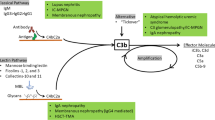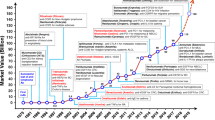Abstract
In this study, we immunized Gb3/CD77 synthase gene (A4galt) knockout (KO) mice with glycosphingolipids (GSLs) extracted from 3 renal cell cancer (RCC) cell lines to raise monoclonal antibodies (mAbs) reactive with globo-series GSLs specifically expressed in RCCs. Although a number of mAbs reactive with globo-series GSLs were generated, they reacted with both RCC cell lines and normal kidney cells. When we analyzed recognized antigens by mAbs that were specifically reactive with RCC, but not with normal kidney cells at least on the cell surface, many of them turned out to be reactive with sulfoglycolipids. Eight out of 11 RCC-specific mAbs were reactive with SM2 alone, and the other 3 mAbs were more broadly reactive with sulfated glycolipids, i.e. SM3 and SM4 as well as SM2. In the immunohistochemistry, these anti-sulfoglycolipids mAbs showed RCC-specific reaction, with no or minimal reaction with adjacent normal tissues. Thus, immunization of A4galt KO mice with RCC-derived GSLs resulted in the generation of anti sulfated GSL mAbs, and these mAbs may be applicable for the therapeutics for RCC patients.







Similar content being viewed by others
References
Houghton, A.N., Mintzer, D., Cordon-Cardo, C., Welt, S., Fliegel, B., Vadhan, S., Carswell, E., Melamed, M.R., Oettgen, H.F., Old, L.J.: Mouse monoclonal IgG3 antibody detecting GD3 ganglioside: a phase I trial in patients with malignant melanoma. Proc. Natl. Acad. Sci. U. S. A. 82, 1242–1246 (1985)
Kennett, R.H.: Hybridomas: a new dimension in biological analyses. In Vitro. 17, 1036–1050 (1981)
Nelson, P.N., Reynolds, G.M., Waldron, E.E., Ward, E., Giannopoulos, K., Murray, P.G.: Monoclonal antibodies. Mol. Pathol. 53, 111–117 (2000)
Boffey, J., Nicholl, D., Wagner, E.R., Townson, K., Goodyear, C., Furukawa, K., Furukawa, K., Conner, J., Willison, H.J.: Innate murine B cells produce anti-disialosyl antibodies reactive with Campylobacter jejuni LPS and gangliosides that are polyreactive and encoded by a restricted set of unmutated V genes. J. Neuroimmunol. 152, 98–111 (2004)
Lunn, M.P., Johnson, L.A., Fromholt, S.E., Itonori, S., Huang, J., Vyas, A.A., Hildreth, J.E., Griffin, J.W., Schnaar, R.L., Sheikh, K.A.: High-affinity anti-ganglioside IgG antibodies raised in complex ganglioside knockout mice: reexamination of GD1a immunolocalization. J. Neurochem. 75, 404–412 (2000)
Boffey, J., Odaka, M., Nicoll, D., Wagner, E.R., Townson, K., Bowes, T., Conner, J., Furukawa, K., Willison, H.J.: Characterisation of the immunoglobulin variable region gene usage encoding the murine anti-ganglioside antibody repertoire. J. Neuroimmunol. 165, 92–103 (2005)
Kondo, Y., Tokuda, N., Furukawa, K., Ando, R., Uchikawa, M., Zhang, Q., Xiaoyan, F., Furukawa, K.: Efficient generation of useful monoclonal antibodies reactive with globotriaosylceramide using knockout mice lacking Gb3/CD77 synthase. Glycoconj. J. 28, 371–384 (2011)
Lingwood, C.A.: Role of verotoxin receptors in pathogenesis. Trends Microbiol. 4, 147–153 (1996)
Fujii, Y., Numata, S., Nakamura, Y., Honda, T., Furukawa, K., Urano, T., Wiels, J., Uchikawa, M., Ozaki, N., Matsuo, S., Sugiura, Y., Furukawa, K.: Murine glycosyltransferases responsible for the expression of globo-series glycolipids: cDNA structures, mRNA expression, and distribution of their products. Glycobiology 15, 1257–1267 (2005)
Okuda, T., Tokuda, N., Numata, S., Ito, M., Ohta, M., Kawamura, K., Wiels, J., Urano, T., Tajima, O., Furukawa, K., Furukawa, K.: Targeted disruption of Gb3/CD77 synthase gene resulted in the complete deletion of globo-series glycosphingolipids and loss of sensitivity to verotoxins. J. Biol. Chem. 281, 10230–10235 (2006)
Kondo, Y., Ikeda, K., Tokuda, N., Nishitani, C., Ohto, U., Akashi-Takamura, S., Ito, Y., Uchikawa, M., Kuroki, Y., Taguchi, R., Miyake, K., Zhang, Q., Furukawa, K., Furukawa, K.: TLR4-MD-2 complex is negatively regulated by an endogenous ligand, globotetraosylceramide. Proc. Natl. Acad. Sci. U. S. A. 110, 4714–4719 (2013)
Kasai, K., Galton, J., Terasaki, P.I., Wakisaka, A., Kawahara, M., Root, T., Hakomori, S.I.: Tissue distribution of the Pk antigen as determined by a monoclonal antibody. J. Immunogenet. 12, 213–220 (1985)
Nudelman, E., Kannagi, R., Hakomori, S., Parsons, M., Lipinski, M., Wiels, J., Fellous, M., Tursz, T.: A glycolipid antigen associated with Burkitt lymphoma defined by a monoclonal antibody. Science 220, 509–511 (1983)
Nudelman, E., Hakomori, S., Kannagi, R., Levery, S., Yeh, M.Y., Hellstrom, K.E., Hellstrom, I.: Characterization of a human melanoma-associated ganglioside antigen defined by a monoclonal antibody, 4.2. J. Biol. Chem. 257, 12752–12756 (1982)
Falguieres, T., Maak, M., von Weyhern, C., Sarr, M., Sastre, X., Poupon, M.F., Robine, S., Johannes, L., Janssen, K.P.: Human colorectal tumors and metastases express Gb3 and can be targeted by an intestinal pathogen-based delivery tool. Mol. Cancer Ther. 7, 2498–2508 (2008)
Kovbasnjuk, O., Mourtazina, R., Baibakov, B., Wang, T., Elowsky, C., Choti, M.A., Kane, A., Donowitz, M.: The glycosphingolipid globotriaosylceramide in the metastatic transformation of colon cancer. Proc. Natl. Acad. Sci. U. S. A. 102, 19087–19092 (2005)
Okada, M., Itoh, M., Haraguchi, M., Okajima, T., Inoue, M., Ohishi, H., Matsuda, Y., Iwamoto, T., Kawano, T., Fukumoto, S., Miyazaki, H., Furukawa, K., Aizawa, S., Furukawa, K.: b-series ganglioside deficiency exhibits no definite changes in the neurogenesis and the sensitivity to Fas-mediated apoptosis, but impairs regeneration of the lesioned hypoglossal nerve. J. Biol. Chem. 277, 1633–1636 (2002)
Senda, M., Ito, A., Tsuchida, A., Hagiwara, T., Kaneda, T., Nakamura, Y., Kasama, K., Kiso, M., Yoshikawa, K., Katagiri, Y., Ono, Y., Ogiso, M., Urano, T., Furukawa, K., Oshima, S., Furukawa, K.: Identification and expression of a sialyltransferase responsible for the synthesis of disialylgalactosylgloboside in normal and malignant kidney cells: downregulation of ST6GalNAc VI in renal cancers. Biochem. J. 402, 459–470 (2007)
Niimura, Y., Ishizuka, I.: Isolation and identification of nine sulfated glycosphingolipids containing two unique sulfated gangliosides from the African green monkey kidney cells, Verots S3, and their possible metabolic pathways. Glycobiology 16, 729–735 (2006)
Furukawa, K., Mattes, M.J., Lloyd, K.O.: A1 and A2 erythrocytes can be distinguished by reagents that do not detect structural differences between the two cell types. J. Immunol. 135, 4090–4094 (1985)
Ikeda, K., Taguchi, R.: Highly sensitive localization analysis of gangliosides and sulfatides including structural isomers in mouse cerebellum sections by combination of laser microdissection and hydrophilic interaction liquid chromatography/electrospray ionization mass spectrometry with theoretically expanded multiple reaction monitoring. Rapid Commun. Mass Spectrom. 24, 2957–2965 (2010)
Satoh, M., Nejad, F.M., Ohtani, H., Ito, A., Ohyama, C., Saito, S., Orikasa, S., Hakomori, S.: Association of renal cell carcinoma antigen, disialylgalactosylgloboside, with c-Src and Rho A in clustered domains at the surface membrane. Int. J. Oncol. 16, 529–536 (2000)
Satoh, M., Handa, K., Saito, S., Tokuyama, S., Ito, A., Miyao, N., Orikasa, S., Hakomori, S.: Disialosyl galactosylgloboside as an adhesion molecule expressed on renal cell carcinoma and its relationship to metastatic potential. Cancer Res. 56, 1932–1938 (1996)
Wiels, J., Holmes, E.H., Cochran, N., Tursz, T., Hakomori, S.: Enzymatic and organizational difference in expression of a Burkitt lymphoma-associated antigen (globotriaosylceramide) in Burkitt lymphoma and lymphoblastoid cell lines. J. Biol. Chem. 259, 14783–14787 (1984)
Mangeney, M., Richard, Y., Coulaud, D., Tursz, T., Wiels, J.: CD77: an antigen of germinal center B cells entering apoptosis. Eur. J. Immunol. 21, 1131–1140 (1991)
Yoda, Y., Gasa, S., Makita, A., Fujioka, Y., Kikuchi, Y., Hashimoto, M.: Glycolipids in human lung carcinoma of histologically different types. J. Natl. Cancer Inst. 63, 1153–1160 (1979)
Osawa, H., Sugano, K., Igari, T., Tai, T., Iwamori, M., Kawakami, M.: Immunohistochemical study of sulfatide expression in gastric carcinoma: alteration of sulfatide expression. J. Clin. Gastroenterol. 25(Suppl 1), S135–140 (1997)
Morichika, H., Hamanaka, Y., Tai, T., Ishizuka, I.: Sulfatides as a predictive factor of lymph node metastasis in patients with colorectal adenocarcinoma. Cancer 78, 43–47 (1996)
Sugiyama, T., Miyazawa, M., Mikami, M., Goto, Y., Nishijima, Y., Ikeda, M., Hirasawa, T., Muramatsu, T., Takekoshi, S., Iwamori, M.: Enhanced expression of sulfatide, a sulfated glycolipid, in well-differentiated endometrial adenocarcinoma. Int. J. Gynecol. Cancer 22, 1192–1197 (2012)
Sakakibara, N., Gasa, S., Kamio, K., Makita, A., Koyanagi, T.: Association of elevated sulfatides and sulfotransferase activities with human renal cell carcinoma. Cancer Res. 49, 335–339 (1989)
Kobayashi, T., Honke, K., Kamio, K., Sakakibara, N., Gasa, S., Miyao, N., Tsukamoto, T., Ishizuka, I., Miyazaki, T., Makita, A.: Sulfolipids and glycolipid sulfotransferase activities in human renal cell carcinoma cells. Br. J. Cancer 67, 76–80 (1993)
Honke, K., Tsuda, M., Hirahara, Y., Ishii, A., Makita, A., Wada, Y.: Molecular cloning and expression of cDNA encoding human 3′-phosphoadenyl- ylsulfate:galactosyl- ceramide 3′-sulfotransferase. J. Biol. Chem. 272, 4864–4868 (1997)
Roberts, D.D., Wewer, U.M., Liotta, L.A., Ginsburg, V.: Laminin-dependent and laminin-independent adhesion of human melanoma cells to sulfatides. Cancer Res. 48, 3367–3373 (1988)
Roberts, D.D.: Interactions of thrombospondin with sulfated glycolipids and proteoglycans of human melanoma cells. Cancer Res. 48, 6785–6793 (1988)
Incardona, F., Calvo, F., Fauvel-Lafeve, F., Legrand, Y., Legrand, C.: Involvement of thrombospondin in the adherence of human breast-adenocarcinoma cells: a possible role in the metastatic process. Int. J. Cancer 55, 471–477 (1993)
Garcia, J., Callewaert, N., Borsig, L.: P-selectin mediates metastatic progression through binding to sulfatides on tumor cells. Glycobiology 17, 185–196 (2007)
Kobayashi, T., Honke, K., Miyazaki, T., Matsumoto, K., Nakamura, T., Ishizuka, I., Makita, A.: Hepatocyte growth factor specifically binds to sulfoglycolipids. J. Biol. Chem. 269, 9817–9821 (1994)
Sandhoff, R., Grieshaber, H., Djafarzadeh, R., Sijmonsma, T.P., Proudfoot, A.E., Handel, T.M., Wiegandt, H., Nelson, P.J., Grone, H.J.: Chemokines bind to sulfatides as revealed by surface plasmon resonance. Biochim. Biophys. Acta 1687, 52–63 (2005)
Popovic, Z.V., Sandhoff, R., Sijmonsma, T.P., Kaden, S., Jennemann, R., Kiss, E., Tone, E., Autschbach, F., Platt, N., Malle, E., Grone, H.J.: Sulfated glycosphingolipid as mediator of phagocytosis: SM4s enhances apoptotic cell clearance and modulates macrophage activity. J. Imunol. 179, 6770–6782 (2007)
Acknowledgments
We thank T. Mizuno and Y. Nakayasu for technical assistance.
This study was supported by a Grant-in-Aid from the New Energy and Industrial Technology Development Organization of Japan (NEDO), and grants-in-Aid for Scientific Research B (15H04696) and Grant-in-aid for Scientific Research on Innovative Areas (23110008) from the Ministry of Education, Culture, Sports, Science and Technology of Japan (MEXT).
Author information
Authors and Affiliations
Corresponding author
Ethics declarations
Conflict of interest
There is no conflict of interest.
Electronic supplementary material
Below is the link to the electronic supplementary material.
Supplemental Table S1
(PDF 147 kb)
Supplemental Table S2
(PDF 39 kb)
Supplemental Table S3
(PDF 72 kb)
Supplemental Fig. S1
Immunization schedule of mice. A4galt KO mice were immunized intravenously or intraperitoneally with glycolipids derived from RCC cell lines as described in “Materials and methods”. Immunization times of mice used for the fusion were 11~14. Serum reactivity check by IF was performed at appropriate time points. (PDF 40 kb)
Supplemental Fig. S2
Specificity of mAb F722-3 analyzed by TLC-immunostaining. TLC-immunostaining was performed with mAb 722-3 (hybridoma supernatant at 1:2 dilution) as described in “Materials and Methods”. BBG, bovine brain gangliosides as standards. SM2 was prepared from African green monkey kidney cells, Verots S3 and its structure was defined as described in Ref. 19. (PDF 25 kb)
Rights and permissions
About this article
Cite this article
Ando, R., Tokuda, N., Yamamoto, T. et al. Immunization of A4galt-deficient mice with glycosphingolipids from renal cell cancers resulted in the generation of anti-sulfoglycolipid monoclonal antibodies. Glycoconj J 33, 169–180 (2016). https://doi.org/10.1007/s10719-016-9654-6
Received:
Revised:
Accepted:
Published:
Issue Date:
DOI: https://doi.org/10.1007/s10719-016-9654-6




